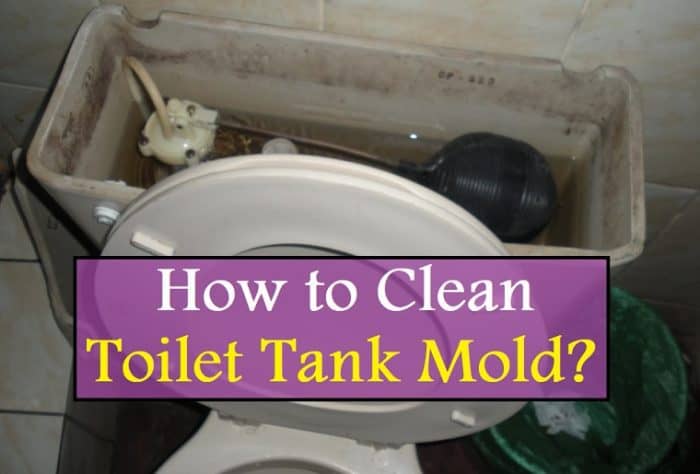Over the period, and with the continuous use of the toilet tank, algae and mold develop. One of the main causative agents of this menace is the dirt in water, especially if it is not clean from the source.
It is even more challenging if the water stagnates for long in the tank. Nonetheless, it is not difficult to clean the mold in the toilet tank. There are several ways with which you can do it.
In this article, we are going to look at some of the ways to get rid of the same. Please read through the same for more information.
What are the main categories of mold?
They are mostly in two forms, and that is the black and the orange mold. For the black types, there are other sub-units of it.
Some of them stay around the porous parts, and hence you will not find it easily on the smooth surfaces of the tank. Other types do live mostly on the edges of the toilet tank or even in the bathtub.
Black mold is not dangerous, and you can control it by regular bleaching. However, it can only be harmful if you start experiencing allergies from the same.
The orange mold, on the other hand, develops around the toilet bowl, mostly on the top level, where the water settles when the tank is full! One of the probable causes of this mold is the bacteria in the water.
It is not a harmful mold, not unless you have allergies to it.
Unlike the black mold, this particular one does have a variety of itself, but it multiplies in its original form!
So how to clean toilet tank mold?
There are several ways to deal with the mold that usually build up in the toilet tank. Here are some of them:
Use of vinegar and baking soda.
The procedure is one of the traditional methods of cleaning toilet products. It is less corrosive and a little harsh on the toilet tank, and hence you do not need to mix it with water before applying to the tank.
The procedure is as follows:
- Add one cup of vinegar to the toilet tank, as well as the bowl.
- Sprinkle the baking soda, both inside the bowl and into the tank as well. Do not forget to apply some under the rim. That is because it is an excellent breeding ground for bacteria and other forms of water contaminants. Leave the mixture open until it begins to fizz out. From there, close the lid and let it settle for an hour or even one-and-a-half hours!
- Take the toilet brush and scrub the inner part of the tank. Scrub it gently so that you do not damage your tank.
- After scrubbing, let it rest for about fifteen to thirty minutes.
- Flush the toilet for about two times so that all the reagents and dirt can go down the drain!
To avoid the frequent buildup of mold and bacteria, consider adding a cup of vinegar to the toilet tank once every two weeks. It acts as a preservative, as well as a preventive mechanism against this menace!
Use of chemical products.
Unlike other forms of cleaning agents, chemical products can be harmful and expensive as well. Not only are they disastrous to the bacteria and mold, but also the user, especially after a prolonged usage period.
When you are using chemicals to clean your toilet, I would always advise you to follow the safety instructions that come with the product. Some of them in the package include gloves, a mask, or even a ventilator.
It helps to prevent touching or taking in the harmful fumes from the reaction. Also included in the pack is a safety instruction manual that you should read and understand before using the chemicals!
I would advise you not to use these chemicals regularly as they can damage the toilet tank within a short time. Aside from that, it is also a health hazard. You should only apply it when the mold is severe, but the other methods of cleaning cannot work.
When cleaning, apply a specific amount as directed by the user manual. You have to mix it with water first before using it to clean. After applying, close both the tank and the toilet bowl, and leave it to settle for about half an hour.
Make sure that you put to all the areas that have mold. When the time elapses, remove the lid and scrub them with a toilet brush, albeit gently. Flush it thrice with clean water to make sure that all the chemicals flow down the drain!
Make it a rule to apply vinegar or even baking soda regularly to keep mold and bacteria from building up.
Use of bleach.
Bleach is one of the most efficient toilet cleaning products. It can kill and remove bacteria and mold, no matter how stubborn it is!
Unlike the chemical cleaning agents, mold cannot develop resistance to the bleach. That means you can use it to clean the toilet for the longest time possible!
Before using the bleach, you have to mix it with water in a ratio of one to ten (1:10). That means if you are using a 100ml bottle to prepare the mixture, only 10ml should be the bleach, and the rest 90ml should be water. The reason for doing this is because bleach is also harmful, just like the chemical component!
As you continue to deal with molds, they keep on resurging all the time. When such a phenomenon begins to occur, then I would advise you to use more bleach in the mixture.
For example, you may choose to mix water and the bleach in the ratio of 2:10 or even 3:10. That, however, depends on how the mold is regenerating.
The procedure is similar to that of other cleaning agents. First, apply the bleach to all the affected parts in the toilet tank and even in the bowl. Seal off the two sections and let it settle for between fifteen to thirty minutes.
When the time elapses, scrub it with the toilet brush and flush it with clean water. I would advise you to rinse it twice or even thrice so that all the bleach will go down the drainpipe.
That is because if you leave its traces in the tank, it may start corroding various parts, and that might be costly to replace in the long run!
To prevent the natural buildup of mold, make it a practice to clean your tank regularly and within short intervals.
Use of detergents.
It is one of the commonly used methods of cleaning the tank. However, it is not the best way of removing mold. Part of the factors that make it popular is because the detergents are cheap and readily available. They are not, however, strong enough to deal with mold unless you use it as a preventive measure against it.
To clean, apply a mixture of detergent to the tank, leave it to settle for about an hour, and scrub it with a brush. Flush it with clean water to wash off the detergent and the dirt!
I would not, however, advise you to use the regular washing detergent to clean it, especially if the mold stains are old and tough. You will require a concentrated agent such as bleach, vinegar, or even chemical for the same.
Is it a normal thing to have mold in the toilet tank?
As long as water remains stagnant in the toilet tank, so does the mold develop! That is the case, mostly with the toilets that remain unused for long.
The same condition remains for those that are not flushed. Such environments are perfect for the development and growth of molds.
To avoid that problem, you should always flush your toilet regularly after every use. Better still, you can make it a practice to rinse it three to four times a day, even if you do not use it.
If the tank develops mold, and you do not work on it, then it will pass it on to the toilet bowl. That will lead to an unhygienic environment in the restroom.
Is the mold dangerous?
It might not be as dangerous as such, but it is not healthy for your home. The mold does not only grow in the toilet bowl and tank but also in a wet or moist environment.
When it spreads to all these parts, then it will even be more harmful, and can cause some health problems! I would, therefore, urge you to get rid of this menace whenever you can.
Does it have a smell?
Yes, mold has an odor. It has the smell of fresh earth, especially when it rains! The more they are concentrated, the smelly it can be. If you pass close to a public shower room, for example, you may notice a stench smell that comes from there. That could be mold!
Conclusion.
Mold develops where water is stagnant for a long time. It also comes to life in a moist environment. There are several ways to get rid of it.
However, you can prevent this buildup by always ensuring that you keep the toilet dry, and at the same time, changing the water in the toilet tank. Clean it regularly to make it free of mold!

